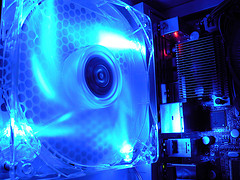Controlling Your Cooling – Fan Speed Control
 A new ‘craze’ that has started over the past couple of years is that of controlling the fan speed of your laptop. Now, the speed that your fan is turning (i.e. its RPM) is controlled by your computer based on input from temperature sensors. Computers don’t work well when they’re too cold or too hot. Now getting too cold isn’t usually a problem unless you’re sitting outside with your laptop in Antartica! Even if it is cold in your house, the laptop produces heat through just being on (and produces more heat with increasing actions and activity on the computer). However, getting too warm can be a very real problem – and a laptop that is too warm can easily become sluggish, slow to respond and eventually crash (or even cut out if the temperature gets too high – this is to prevent damage to your hardware).
A new ‘craze’ that has started over the past couple of years is that of controlling the fan speed of your laptop. Now, the speed that your fan is turning (i.e. its RPM) is controlled by your computer based on input from temperature sensors. Computers don’t work well when they’re too cold or too hot. Now getting too cold isn’t usually a problem unless you’re sitting outside with your laptop in Antartica! Even if it is cold in your house, the laptop produces heat through just being on (and produces more heat with increasing actions and activity on the computer). However, getting too warm can be a very real problem – and a laptop that is too warm can easily become sluggish, slow to respond and eventually crash (or even cut out if the temperature gets too high – this is to prevent damage to your hardware).
Now as your computer controls the fan speed automatically – is it really a good idea to interfere with its automatic settings. Well, yes and no. There are different circumstances where it is beneficial and others where it’s not really advisable.
Firstly, a decision based on whether to control your fan speed manually (or more accurately semi-manually) should be made for technical reasons, by a technically experienced person. Not just because it seem ‘fun’ because that can cause problems, as can not knowing what you are doing.
The (shockingly) primary reason that people have given on the Internet for wanting to control fan speed is that they want to ‘cool down the laptop so it doesn’t burn their legs’. We cannot emphasise enough just how shockingly unadvisable this is! The fans are there to keep your computer working, not your legs cool! If the laptop is to warm for your legs, place another surface inbetween you and your laptop (like a tray) or put it back on a table!! Fan control should only be ever used for the benefit of your computer, not your own personal body temperature!
Now that we’ve got that out of the way, the technical reason for controlling your fan speed is usually because the operating system fan speed control is failing to work or one or more of your computers temperature sensors has broken – both of these issues can cause the computer to set an incorrect fan speed and therefore overheat.
It must be advised that it is highly unlikely that your computer will suffer damage due to overheating, even if you don’t control the system fan speed and the system is also failing to adequately control the systems fan speed. All modern computers are set to ‘cut-out’ once the temperature of your system reaches a ‘critical’ level. It does this to ensure that the computers hardware is not damaged due to overheating. If this is the case, switching the computer straight back on, without leaving it to cool down will likely result in another ‘cut out’ shortly after turning the machine back on.

Firstly, its advisable to know your stats regarding the temperatures of the different parts of your system. iStatPro is a really good utility / widget for this for users of Mac OS X. There are also other similar free tools available for Windows based users. Now iStatPro has many interesting and useful statistics – but for our purposes at the moment, we’re most interested in the temperature stats.
Now, the optimum and allowable temperatures are different for each system / laptop – to find out information for your particular system and laptop, you can Google for information specific to your system / laptop or consult the manual that came with it.
 Now, with iStatPro (and many other free tools) you can usually see if something is wrong with one of the temperature sensors by using common sense. If a temperature readout isn’t possible (or extremely unlikely) it could indicate that you have a problem with that temperature sensor. For example, if 100 degrees Celsius is shown on one of the temperature sensors, its nigh on impossible that your laptop would still be functioning. Equally if its showing -20 degrees Celsius its also night on impossible that your laptop would still be functioning! Also, if no readout is displayed persistently for a certain sensor (there will be occasional times when no temperature is displayed due to data being temporarily unavailable) it’s likely theres a problem with that sensor.
Now, with iStatPro (and many other free tools) you can usually see if something is wrong with one of the temperature sensors by using common sense. If a temperature readout isn’t possible (or extremely unlikely) it could indicate that you have a problem with that temperature sensor. For example, if 100 degrees Celsius is shown on one of the temperature sensors, its nigh on impossible that your laptop would still be functioning. Equally if its showing -20 degrees Celsius its also night on impossible that your laptop would still be functioning! Also, if no readout is displayed persistently for a certain sensor (there will be occasional times when no temperature is displayed due to data being temporarily unavailable) it’s likely theres a problem with that sensor.
Malfunctioning sensors can lead to poor fan control and ultimately lots of crashes and cut outs.
 Tools such as SMC Fan Control are freely available (there are others for different operating systems as well) which allow you to control the ‘minimum fan speed’ – i.e. it will still allow the system to go above the fan speed set if it determines that this is required. This is a very important feature as if the fan speed didn’t move above the set speed when required this could make the problems even worse. Also with SMC Fan Control, there is a minimum fan speed which it won’t let you go below – this is set to the fan speed that is the absolute minimum that your system should be running at – anything below this, would be dangerous.
Tools such as SMC Fan Control are freely available (there are others for different operating systems as well) which allow you to control the ‘minimum fan speed’ – i.e. it will still allow the system to go above the fan speed set if it determines that this is required. This is a very important feature as if the fan speed didn’t move above the set speed when required this could make the problems even worse. Also with SMC Fan Control, there is a minimum fan speed which it won’t let you go below – this is set to the fan speed that is the absolute minimum that your system should be running at – anything below this, would be dangerous.
It’s important to pick a reputable tool when choosing programs to control fan speed as there is the possibility that poorly written programs can lead to the problem getting worse or damage being done to your system. Try the tools above or if you try other tools, ensure you read reviews about it and take advice from people.
Of course, if this is a little scary and you’d prefer a less technical option (or need an additional option as the solutions above aren’t completely solving the problem when used alone) then you can always try laptop cooling mats/pads/stands which are available from many online stores and most computer shops. And of course there is the old completely non technical solution of pointing a desktop fan at a high speed in the direction of your laptop – which although inconvenient can be highly effective!
Image: aresauburn.


>> And of course there is the old completely non technical solution of pointing a desktop fan at a high speed in the direction of your laptop – which although inconvenient can be highly effective!
OR you could get a better laptop.
😉
Every laptop currently in existence could suffer from this problem!! ;).